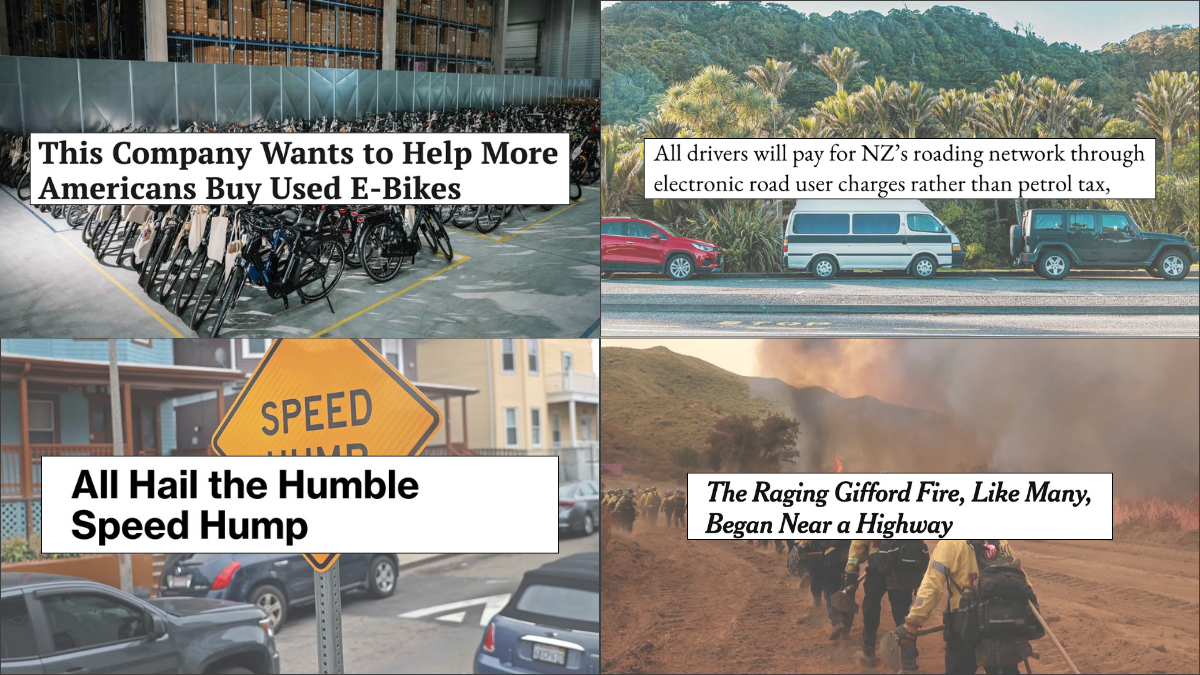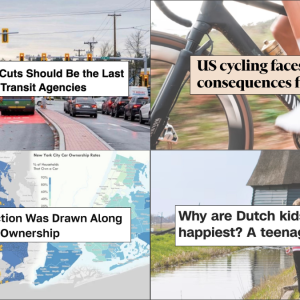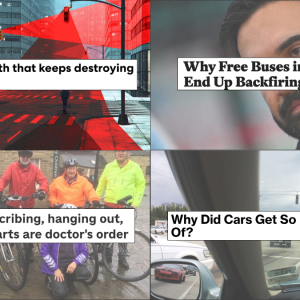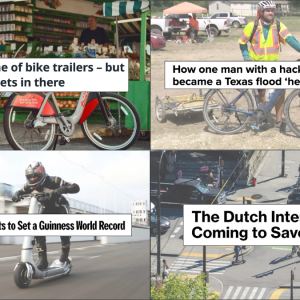Hi friends. Welcome to the week.
And now a word from our sponsor: If you love cycling, you will not want to miss this weekend’s Portland Criterium races. Organizers have two fun-filled days planned and will bring the speed and spectacle of competitive community bike racing (and running!) to downtown Portland and the Lloyd. Check out PortlandCriterium.com for more info.
And with that, here are the most notable stories that came across my desk in the past seven days…
Parenting in America: It’s maddening that our government and judicial system have created inherently deadly road conditions and then when people try exist among them, it’s innocent parents who get jailed for letting their kids walk to the store. What a shithole country this is sometimes. (NY Times)
Used e-bikes: The author of this piece says a company called Upway wants to be known as the “Carvana of e-bikes” as it looks to tap the market for good quality, used e-bikes. (Streetsblog USA)
Playing politics with our lives: Some political candidates are so desperate and devoid of sound policy ideas that they stoop to campaigning against proven bike infrastructure in a bid to gin up anger among their base. (Boston Globe)
We need noise cameras: As someone who lives just a few hundred yards from an I-5 freeway onramp, I’d love to catch all the assholes who gun their engines onto the freeway. Loud noise is yet another negative externality of driving. (And oh look, the new company PBOT contracts with offers this technology.) (Wall St. Journal)
Shared micromobility: Shared scooter and bike rental systems across America have proven successful and their use reached an all-time high in 2024. Now, let’s double-down on our public investment in them! (NABSA)
New Zealand funding innovation: Oregon legislators might want to make a fact-finding mission to New Zealand, where they seem to have accomplished something Oregon had dreamt about for decades: Moving from a gas tax to a road user charge. (Interest NZ)
Another reason driving should be more expensive: A large number of major wildfires start near highways because of cars, yet people who drive these cars never pay for this negative consequence of their actions. But yeah, let’s keep arguing about how ‘cyclists don’t pay.’ (NY Times)
Speed hump salute: I actually have come to not like speed humps because of how they hurt my but whenever I roll over them, but I can appreciate how effective they are in slowing down drivers so I guess I’m a reluctant fan. (Bloomberg)
Thanks to everyone who sent in links this week. The Monday Roundup is a community effort, so please feel free to send us any great stories you come across.







Thanks for reading.
BikePortland has served this community with independent community journalism since 2005. We rely on subscriptions from readers like you to survive. Your financial support is vital in keeping this valuable resource alive and well.
Please subscribe today to strengthen and expand our work.
I love the idea of noise pollution cameras! We live close to 217 (currently being widened) and endure the sounds of car tires and illegal exhaust daily.
Yeah, same. I live near the Terwilliger curves on I-5 and between all the big freight trucks illegally using their unmuffled engine brakes as they enter the curves and the street racers with their modified exhausts zipping through, the noise at night makes leaving the windows open in summer a challenge.
“I love the idea of noise pollution cameras!”
I do too. The good news is that as we phase out fossil fuel vehicles, the need for such cameras will greatly diminish.
I live off of Holgate and I can assure you tire noise is just as bad on EVs as it is traditional cars. Loud exhaust systems are annoying, but relatively infrequent. It’s the constant tire noise that drives me crazy.
Noise cameras won’t help much with tire noise.
“I’d love to catch all the assholes who gun their engines onto the freeway. Loud noise is yet another negative externality of driving.”
1000 percent yes!!
The intentionally raised noise degrades the humanity of those forced to constantly listen to it. When we were being gentrified out I was frantic looking for work and found something near Olympia. We didn’t have time to explore or do much follow up and picked a place on a road that turned out to lead to an ever increasing suburb/small town in its own right. The arrogant bad people in their cars and trucks daily show their contempt for anyone else as they floor it from an intersection thinking they are the dukes of hazard or some other motor fantasy.
They are all speeding, but its the noise that is continually awful. I would be sooo happy to have a sound camera sending out fines to all the people who willfully modified their vehicles to make far more noise than it should. I wouldn’t even care where the money went, just that the jerks were punished for punishing us with their noise.
Crazy to think it’s been 14 years since I started lobbying for noise pollution cameras. I’ve been through plenty of nuisance disturbances in other parts of town, but to me there is still no better way break up the silence of a good night’s sleep than with an 18-wheeler with an air brake coming in hot off I5 and barreling down Going to Swan Island.
It’s funny because the problem for me is usually that people insist on entering the freeway at 40 mph, which makes me crazy
Weird how there are so many ebikes on the used market, I was told that they’d be life-changing transformative tools that would enable the revolution.
Yet apparently quite a few are just languishing in a garage somewhere, forgotten and unloved
In a country of 340 million people where between 1 and 1.2 million ebikes are sold each year it’s not actually that weird that there are enough people selling used ebikes to make it profitable for a company to spring up as a used ebike retailer.
I’ve personally considered selling mine because I bought it when I had a 25 mile commute, but I now only need to bike 5 miles per day. I’m sure there other people in my situation, people who have chosen to upgrade their ebikes, people who decided they don’t like riding on hostile infrastructure, and yes people who never really used their bikes who just want to sell them. Just as no one would argue that the existence of a market for used cars means that people don’t find cars useful, the presence of a healthy used market for ebikes doesn’t mean that ebikes aren’t life-changing transformative tools for many.
Also, there are quite a few used bikes for sale that are stolen. I’m sure my first ebike showed up for sale somewhere, even though I had no wish to sell it.
No doubt a lot of bikes of any type are languishing. Ebikes are sort of a new category, people might buy at the wrong price point or impulsively get something they don’t know how to use effectively. However a good number of ebike users are not shy about telling you that it’s changed their life, to the point of replacing their car entirely.
One cohort of bikes that’s pretty quiet is the early adopted Dutch built bakfietsen. I’ve seen one in the last year but they seem rare. I feel there might be a few for sale if you talked to the right person.
Shouldn’t this read, “to not like speed humps” and “hurt my butt“?
Yes it should!
It’s a good well-written article! I like how they distinguish between speed bumps, speed humps, and speed pillows. The Romans had speed pillows in most of their cities, just barely spaced wide enough to allow horse carts to pass through very slowly, but close enough for pedestrians to cross on the raised crosswalk to avoid rain water running through the street. Small perpendicular low ridges of gravel or rock on sloped roadways have been used for millennia to control the flow of runoff and help prevent road material erosion, as well as control traffic speeds – the citation of some obscure university professor notwithstanding.
I think the speed humps article misses something important. It’s only about cars. A lot of the places where humps are installed aren’t only places where we’re trying to slow down cars, they’re places where we’re trying to encourage biking.
If all that matters is slowing down cars, hump away. Maybe on a street that gets a lot of cut-through traffic or a street near a school. If we’re trying to make a good bike route, the fact that it sucks to bump over them matters. We’re often carrying stuff on our backs, with only our legs as suspension. Maybe the ideal speed hump isn’t jarring on a bike, but after a few years will it be in ideal shape? If a hump is installed on a street whose pavement is half a century old and has developed a lot of unevenness, is it even possible to consistently make humps that are comfortable for biking?
This article certainly represents the trend to go all-in on humps, but the experience of using bike routes should be better than slamming over bumps twice a block. On those streets we really should be doing something more thoughtful.